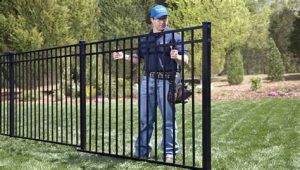Explore essential guidelines on regulatory variations, zoning restrictions, and permitting processes for both commercial and residential fences. Ensure compliance and avoid issues with your fence project!When it comes to fencing, the rules and regulations can vary significantly between commercial and residential properties. Understanding these differences is crucial for property owners looking to enhance their space while staying compliant with local regulations. From zoning restrictions to specific permitting processes, the requirements for commercial fences often diverge from those applicable to residential fences. This blog post will explore the key regulatory variations that impact fence installation, outlining the permitting processes for both commercial and residential settings. Additionally, we’ll delve into the factors that can influence permit approval, helping you navigate the complexities of fencing laws effectively. By the end, you’ll be equipped with the essential knowledge to make informed decisions about your fencing needs, whether for a business or a home.
Regulatory Variations
When considering the installation of fences, both commercial and residential properties must adhere to various regulatory variations. These regulations can significantly impact the design, height, materials, and overall compliance for fences. Understanding the specific laws that govern commercial versus residential fencing is crucial, as these can differ widely based on location and property type.
For instance, commercial fences are often subject to stricter regulations due to their intended use and the potential impact on the surrounding community. Local zoning laws may dictate how high a fence can be, what materials may be used, and even the purpose of the fence, such as whether it needs to provide security or simply delineate property lines.
In contrast, residential fences typically have more lenient regulations, although homeowners must still navigate local ordinances, homeowners’ association rules, and neighborhood covenants.
Zoning Restrictions for Commercial Fences
When it comes to constructing commercial fences, understanding the zoning restrictions in your area is crucial. These restrictions can vary significantly between different locations and types of properties. Often, commercial zones have specific regulations regarding the height, material, and design of fences that must be adhered to in order to maintain a certain aesthetic and functional quality in the neighborhood.
Zoning laws are enforced by local jurisdictions and can include provisions that dictate not only how tall a fence can be but also what types of materials are acceptable. For example, a commercial property located near a residential area might be limited in height to avoid obstructing views or light for nearby homes. In contrast, an industrial zone might allow for taller, more robust fencing to secure the premises effectively. It’s essential to consult your local zoning ordinance before starting any fencing project to ensure compliance.
- Height Limits: Many jurisdictions specify maximum height limits for fences, especially in areas adjacent to residential properties.
- Materials Used: Certain materials might be prohibited or restricted in commercial zones to maintain a uniform appearance.
- Setback Requirements: Commercial fences may need to be set back a certain distance from property lines.
By understanding and adhering to zoning restrictions, you can ensure that your commercial fence project proceeds without legal complications or fines. Always check with local ordinances or consult a lawyer specializing in real estate to get the most accurate and up-to-date information.
Permitting Process for Commercial Fences
When it comes to erecting a fence for commercial properties, understanding the permitting process is crucial. Unlike residential fences, which may have more lenient regulations, commercial fences often require a more detailed permitting procedure. This is due to various factors, such as the size, purpose, location, and materials used in the fence design.
- Research Local Regulations: Before initiating the process, it’s essential to review local zoning laws and regulations that pertain to commercial properties.
- Prepare Required Documentation: Most cities require specific documentation, such as site plans, fence designs, and construction materials.
- Submit the Application: This involves filling out the necessary forms and paying any associated fees to the local government or zoning office.
- Wait for Review: Once submitted, the application will go through a review process, which may involve public notices or hearings.
- Receive Approval or Modifications: After review, you will receive an approval or potentially need to make modifications to your plans based on feedback from the authorities.
In some cases, specific additional permits may be necessary if the fence installation affects utilities or requires structural considerations. It’s advisable to consult with a professional or local zoning office to ensure compliance with all local ordinances and to streamline the permitting process.
Residential Fence Permit Requirements
When planning to install a fence around your home, it is crucial to understand the residential fence permit requirements that may apply in your municipality or county. These requirements can vary significantly depending on your location, so it’s important to familiarize yourself with local regulations before proceeding.
Generally, a permit is necessary for installing fences that exceed a certain height or are built in specific zones. The typical height limit for residential fences ranges from 4 to 6 feet, but this may change based on local laws, ensuring that the fence does not obstruct the view for drivers and pedestrians.
| Requirement | Description |
|---|---|
| Permit Application | Submit an application to the local building authority, detailing the fence’s height, materials, and location. |
| Property Lines | Confirm property boundaries to avoid disputes with neighbors. |
| Neighborhood Restrictions | Check for any homeowners’ association (HOA) rules that could affect your fence design. |
Moreover, certain types of materials and designs may require additional considerations, particularly if you reside in a historic district or an area with strict aesthetic guidelines. It’s always prudent to consult with your local zoning office or a professional to ensure compliance with all regulations and to avoid penalties.
Factors Impacting Fence Permit Approval
When it comes to securing a fence permit, several factors can influence whether or not your application will be approved. Understanding these factors can help you navigate the permitting process more effectively.
One of the primary considerations is local zoning laws. Different areas may have specific regulations regarding the height, type, and design of fences. If your proposed fence does not comply with these regulations, your permit application may face rejection.
Another important factor is the property setback requirements. Many jurisdictions require fences to be set back a certain distance from property lines. Failure to adhere to these regulations can lead to approval delays or outright denial of your fence permit.
| Factor | Impact on Approval |
|---|---|
| Local Zoning Laws | Must comply to avoid rejection |
| Property Setback Requirements | Failure to meet can delay or deny approval |
| Design Considerations | Must align with community standards |
Additionally, the design of the fence itself can impact approval. Many communities have aesthetic standards, meaning your fence may need to blend with the surrounding environment or adhere to certain styles. It’s essential to consult with local authorities or neighborhood associations before submitting your permit application.
Lastly, any appeals or objections from neighbors can also affect the approval process. If someone raises concerns about your fence, it may lead to a more thorough review or even a potential denial. Ensuring open communication with your neighbors before applying can mitigate this risk.
Frequently Asked Questions
What are the main differences in permitting for commercial and residential fences?
Commercial fences generally have stricter permitting requirements than residential fences due to local zoning regulations and potential impacts on the surrounding environment.
Are there specific height restrictions for commercial fences?
Yes, height restrictions for commercial fences can vary significantly by jurisdiction and are often greater than those for residential fences, depending on the type of business and its location.
Do commercial fences require more extensive plans for approval?
Yes, commercial fences often require detailed site plans and engineering drawings to be submitted for review, while residential fence permits may be simpler and quicker to obtain.
Can homeowners build a fence without a permit?
In many jurisdictions, homeowners can build a fence without a permit if it meets specific height and material requirements, but it’s essential to check local regulations to be sure.
What types of materials are commonly approved for commercial fences?
Commonly approved materials for commercial fences include chain link, metal, vinyl, and masonry, as they are durable and secure for business properties.
Are there any zoning restrictions for residential fences?
Yes, zoning restrictions for residential fences can include height limits, material types, and specific setbacks from property lines, which vary by locality.
What should I consider before applying for a permit for a fence?
Before applying, consider the purpose of the fence, its design, potential neighborhood impacts, any existing local codes, and whether you need to consult with neighbors or an HOA.





